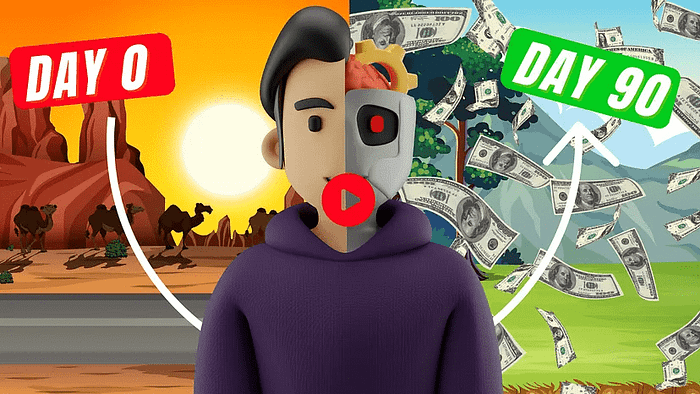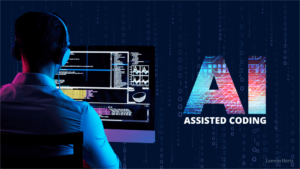How to Build a $1 Billion AI Business Solo: A Teacher’s Guide
“AI will soon make it possible for one person to build a billion-dollar company.”
This profound statement from the founder and CEO of OpenAI might sound impossible to most people, but it’s rapidly becoming reality.
In this comprehensive guide, I’ll walk you through the three-step process that makes building a billion-dollar AI business possible today, not in some distant future.
This exact framework has enabled entrepreneurs to double their businesses in just three months, and it can work for you too, whether you’re just starting out or already running a thriving business.
We strongly recommend that you check out our guide on how to take advantage of AI in today’s passive income economy.
Table of Contents
The Foundation: Choosing the Right Business Model
The Billion-Dollar Business Challenge
The first challenge in building a billion-dollar business is recognizing that not all business models can reach this milestone.
We need to focus on building a business with the highest likelihood of reaching a billion-dollar valuation.
When making this critical decision, there are three key factors to consider that will position you for maximum success and scalability.
Key Factor #1: Product Delivery Without Human Fulfillment
The first essential criterion is creating a product that doesn’t require a person to fulfill it.
Since we’re building this business solo, we need a product that delivers value without human involvement in the delivery or fulfillment process.
This automation is crucial because it removes the most significant bottleneck in scaling a business: human time and capacity.
Key Factor #2: Global Scalability
The second crucial element is selecting a business that’s highly scalable, allowing you to target customers online regardless of geographical location.
If your business model doesn’t have global potential, it’s unlikely to reach billion-dollar status.
The ability to serve customers around the world without physical limitations drastically expands your market potential and revenue ceiling.
Key Factor #3: High Profit Margins
The third vital component is building a highly profitable business.
When discussing a $1 billion business, we’re talking about the company’s valuation, meaning it must generate hundreds of millions in revenue with substantial profit margins.
Lower-margin businesses require significantly more revenue to achieve the same valuation, making the billion-dollar milestone much harder to reach.
The Ideal Business Model: Software as a Service (SaaS)
After analyzing these three criteria, it becomes clear that only one business model truly hits all the requirements: a software business, specifically Software as a Service (SaaS).
SaaS perfectly aligns with our three key factors:
- The product delivers itself to customers, who simply pay for a subscription or credits to access it.
- You can scale globally without geographical limitations.
- While other businesses typically have profit margins of 30-40% at best, software businesses can achieve up to 90% profitability, allowing these companies to sell for up to 10 times their annual revenue.
Numerous examples validate this approach: SendGrid, an email marketing tool, sold to Twilio for $3 billion; GitHub sold to Microsoft for $7.5 billion; and Figma sold to Adobe for $20 billion.
These tremendous exits demonstrate the unique potential of the SaaS model to create massive valuations.
Step 1: Building Your AI-Powered Software Business
The first question many ask is: “How do I build an AI-powered software business?”
The answer lies in leveraging new AI coding platforms that enable anyone—regardless of technical background—to build sophisticated applications, enhance them with AI capabilities, and start acquiring paying customers.
AI Coding Platforms for Non-Technical Founders
One such platform is Lovable, an AI coding platform specifically designed for non-technical people (though coders can access all the code too).
This type of platform allows you to build applications through simple prompts rather than complex coding.
For example, you could prompt: “Build an Airbnb clone for students to find and book washing machines near their campus.”
The platform then generates the code in the background, creating not just designs or a website, but a functional web application complete with database integrations, payment processing, and authentication (sign-in/sign-out functionality).
In just minutes, you can have a first version of your application that includes features like campus search functionality and machine listings.
From there, you can adapt the application via additional prompts: “Could you add authentication?” or “Please attach this to a database.”
Without any coding skills, you can build and launch your product to market.
Alternative platforms include Bolt.new and Replit, all offering similar capabilities for non-technical founders.
For those with more technical skills, these platforms allow direct access to the codebase for customization.
Mobile App Development
If you’re interested in mobile app development, platforms like Expo provide similar capabilities, allowing you to build mobile applications using AI assistance and minimal technical knowledge.
The goal during this phase is finding product-market fit—adapting your product until it properly fits the market and people are willing to pay for it.
With persistence and iteration, this approach can bring you to approximately $100,000 in revenue.
Step 2: Creating Scalable Processes Through Automation
As your business grows and you acquire customers, you’ll face a new challenge: being too busy with day-to-day operations.
This becomes the biggest bottleneck in building a $1 billion solo business.
The solution? Creating scalable processes that free up your time through intelligent automation.
Targeting Repetitive Tasks
The first targets for automation should be your repetitive tasks—those mundane, energy-draining activities you perform day after day.
If you don’t reclaim this time, you’ll be stuck working in your business rather than on your business, severely limiting your growth potential.
The good news is that once you’re working with real customers, you’ll encounter specific problems that can be solved through automated workflows.
These automations handle problems without requiring your presence each time, effectively eliminating repetitive tasks.
Powerful Automation Platforms
Several tools can help create these automations exactly as you need them:
- Need to onboard and educate new customers? There’s an automation for that.
- Want to avoid repetitive emails? There’s an automation for that.
- Need to write customer proposals? There’s an automation for that.
Platforms like Zapier, Make, and N8N allow you to create incredibly powerful automations that run while you sleep.
The first principle is to identify where you spend most of your time and determine how to automate those tasks, freeing you to focus on building the business.
These automations can be surprisingly sophisticated.
For instance, you could create an automation that monitors a Slack channel and automatically generates optimized LinkedIn posts from your voice messages.
The automation could send your message to ChatGPT for initial drafting, then to Claude for editing, before delivering the finished post back to you as a text file—all without your direct involvement.
By automating your repetitive tasks, you effectively buy back your time, allowing you to focus on strategic growth initiatives rather than day-to-day operations.
Step 3: Building Your AI Team
After creating a scalable product and automating repetitive tasks, the final step is building a team to execute and bring your business to billion-dollar status.
But wait—isn’t this about building a billion-dollar business solo?
Yes, but I’m talking about building an entire team of AI agents, each handling specific tasks at a very high level of competence.
Understanding AI Agents
AI agents are more than simple automations—they’re autonomous entities that can be trained on specific knowledge to perform specific tasks.
What makes agents particularly powerful is their ability to learn by doing, improving their performance the more they complete a task.
They can determine what next steps to take, much like a human employee.
Think of the difference this way: automations are like interns—they perform very specific tasks exactly as instructed.
AI agents are more like full-time employees, capable of executing tasks with the skill of a mid-level professional.
Tools for Building AI Agents
Several tools make building AI agents accessible, even for non-technical people:
For non-technical users, platforms like Lindy allow you to build custom agents based on specific use cases.
For example, you could create an agent that joins your Zoom meetings, produces a full transcript, transforms that transcript into action items, and sends those items to your project management tool.
Lindy’s simplicity makes it accessible to anyone—you select a trigger event, connect it to your apps, and provide custom instructions via AI.
The platform includes numerous templates and integrates with tools you likely already use.
For those with more technical confidence, platforms like N8N offer more powerful capabilities for complex, custom jobs.
N8N even allows self-hosting, significantly reducing the cost of running these agents.
What AI Agents Can Do
With a team of AI agents, you can handle numerous business functions at a high level:
- Customer support
- Content creation for marketing and lead generation
- Prospect calling and question answering
- Proposal generation
- Marketing performance analysis
These agents effectively become your workforce, allowing you to scale operations without hiring human employees.
The Path to a Billion-Dollar Solo Business
Reflecting on the original quote about building billion-dollar businesses solo, we can now see how it’s becoming possible:
- Build highly scalable products (SaaS) that can be sold and scaled globally
- Automate all time-consuming tasks to reclaim your attention and energy
- Build an army of AI agents capable of performing tasks at a professional level
The founder of OpenAI not only believes in this vision but has made bets with friends about who will build the first one-person billion-dollar business.
The Critical Starting Point: Product-Market Fit
While this framework provides a clear path to building a billion-dollar solo business, it’s essential to remember that everything hinges on finding product-market fit.
Nothing in this guide is useful unless you have your first paying customers.
The journey begins with validating your idea and securing those initial customers.
From there, the combination of AI-powered software development, intelligent automation, and AI agents creates an unprecedented opportunity for solo entrepreneurs to build businesses of extraordinary scale.
As AI technology continues to advance, the barriers to building massive businesses continue to fall.
The billion-dollar solo business isn’t just a possibility—it’s an emerging reality that forward-thinking entrepreneurs are already beginning to realize.
Conclusion
Building a billion-dollar business as a solo entrepreneur would have seemed impossible just a few years ago.
Today, through the transformative power of AI, it’s becoming increasingly feasible.
By following the three-step framework outlined in this guide—building a SaaS product using AI development tools, implementing powerful automations, and deploying teams of AI agents—you can create a business with unprecedented scale and efficiency.
The key is starting with a validated idea that attracts paying customers, then leveraging AI at every step to multiply your capabilities far beyond what any individual could traditionally accomplish.
The billion-dollar solo business represents a new frontier in entrepreneurship, one where a single person with the right approach can build something truly extraordinary.
The tools, frameworks, and strategies exist today—the only question is who will seize this opportunity first.

We strongly recommend that you check out our guide on how to take advantage of AI in today’s passive income economy.




